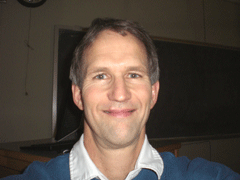Math on the Range
Air Date: Week of February 8, 2008

Dave Tisch (Photo: Dave Tisch)
Host Bruce Gellerman follows up on an interview about carbon-neutral buffalo ranching. He chews the numbers for grass vs. grain-fed livestock, and tells us how each contributes to our individual carbon footprints.
Transcript
GELLERMAN: And also this clarification: I recently interviewed Ken Klemm, who raises 600 head of buffalo on his Kansas ranch and says unlike beef cows, buffalo, or bison, are carbon neutral because of what they eat—grass—versus grain for cows. But when you have to include transporting the meat to market, and consider the total CO2 foot print, ah—then the buffalo guy Klemm says the calculations gets complicated.
KLEMM: Well, I guess we'd have to sit down and do the math, wouldn't we?
GELLERMAN: Well in the land where seldom is heard a discouraging word, we heard from one listener who actually did the math. David Tisch is a professor at the College of Agriculture and Technology at the State University of New York at Cobleskill – and he had something of a beef with our story.
TISCH: Well, not exactly a beef. I guess I do agree with Ken Klemm in some aspects but I think that it’s a little bit more complicated than just substituting buffalo for beef. The real question is grass-fed versus grain-fed. And buffalo can be grain-fed and many are and beef animals can be grass-fed and many are. And in fact, prior to World War Two, most beef animals in this country were produced on grass. But, what’s happened now, a lot’s changed, and it’s cheaper to produce beef on grain than it is to produce them on grass.
GELLERMAN: And what’s the relationship between grain and CO2 emissions?
TISCH: Well, grasses are perennials. And that means that they grow back year after year and there’s not a lot of fuel used to produce the grasses. Grains, however—when you feed animals grain you really mean you’re feeding them corn and corn is an annual. And that means every year you have to plow, plant, fertilize, spray, harvest it, dry it and grind it. There’s a lot of inputs when you’re producing grain for grain-fed beef. But, the reality is that it’s cheaper now to produce grain-fed animals than grass-fed.
GELLERMAN: So, let’s do a hypothetical. Say you’ve got in stall number one, animal ‘A.’ This animal was grain-fed and it was eaten in let’s say in Fort Collins, Colorado, where it was raised. What’s the C02 footprint of that animal?

Dave Tisch (Photo: Dave Tisch)
GELLERMAN: So more C02 is produced than the steak itself?
TISCH: That’s right. More C02 is produced during the production when it’s grain-fed than it would be actually for transportation if you didn’t use grain.
GELLERMAN: Okay, then. Behind stall number two we’ve got animal ‘B.’ And this one was not grain-fed but it was shipped from say Fort Collins, Colorado to me, here in Boston. What’s the CO2 footprint of that one?
TISCH: That one’s CO2 is about .3 pounds of carbon dioxide.
GELLERMAN: Whoa! Big difference.
TISCH: There really is a big difference.
GELLERMAN: So it’s not the transportation; it’s the grain.
TISCH: That’s right. All the inputs of fuel to produce the grain result in more carbon dioxide emission than even transportation 2,000 miles.
GELLERMAN: So Ken Klemm’s claim and the Buffalo Guys is correct then?
TISCH: It really is correct. But if everybody decided to switch to a grass-fed beef product without changing their consumption, there would be another impact on the environment, because it takes more land to produce grass-fed beef than it does to produce grain-fed. So I think the bottom line is that everybody should be eating grass fed—less impact on the environment in terms of CO2 emissions, but we should be eating less beef because less beef means that there won’t be additional land having to be devoted to beef production.
GELLERMAN: Well, a lot to chew on.
TISCH: (laughs) It really is. It’s quite a complicated deal.
GELLERMAN: David Tisch is a professor at the College of Agriculture and Technology at the State University of New York at Cobleskill. Well professor, I really enjoyed our conversation. Thanks a lot!
TISCH: You’re welcome.
[SOUND OF COWS]
Links
Living on Earth wants to hear from you!
Living on Earth
62 Calef Highway, Suite 212
Lee, NH 03861
Telephone: 617-287-4121
E-mail: comments@loe.org
Newsletter [Click here]
Donate to Living on Earth!
Living on Earth is an independent media program and relies entirely on contributions from listeners and institutions supporting public service. Please donate now to preserve an independent environmental voice.
NewsletterLiving on Earth offers a weekly delivery of the show's rundown to your mailbox. Sign up for our newsletter today!
 Sailors For The Sea: Be the change you want to sea.
Sailors For The Sea: Be the change you want to sea.
 The Grantham Foundation for the Protection of the Environment: Committed to protecting and improving the health of the global environment.
The Grantham Foundation for the Protection of the Environment: Committed to protecting and improving the health of the global environment.
 Contribute to Living on Earth and receive, as our gift to you, an archival print of one of Mark Seth Lender's extraordinary wildlife photographs. Follow the link to see Mark's current collection of photographs.
Contribute to Living on Earth and receive, as our gift to you, an archival print of one of Mark Seth Lender's extraordinary wildlife photographs. Follow the link to see Mark's current collection of photographs.
 Buy a signed copy of Mark Seth Lender's book Smeagull the Seagull & support Living on Earth
Buy a signed copy of Mark Seth Lender's book Smeagull the Seagull & support Living on Earth

